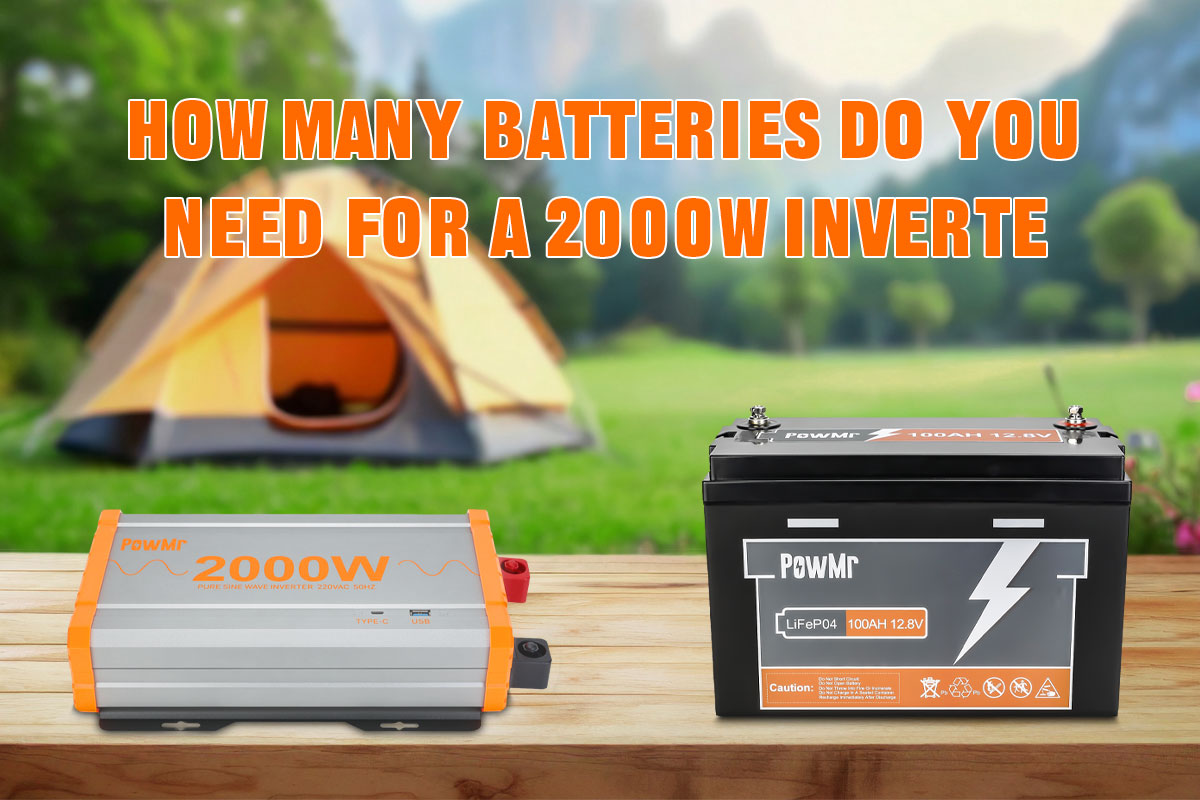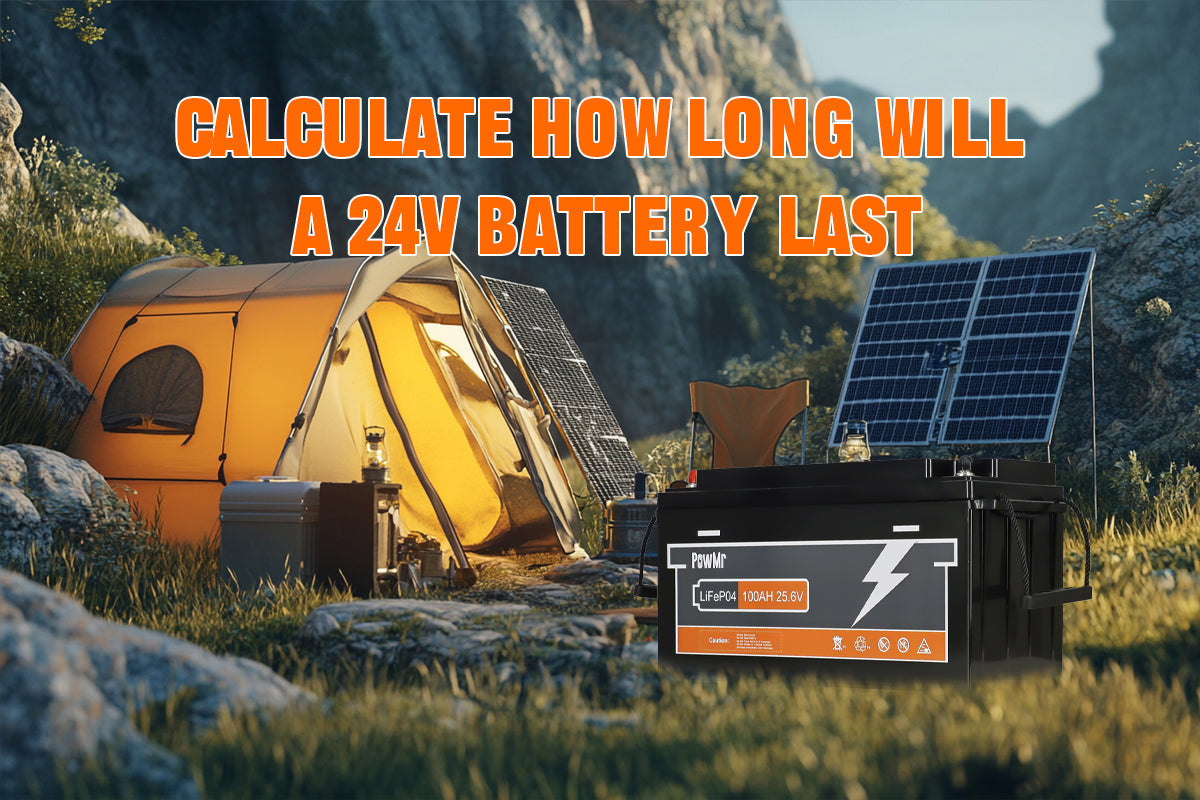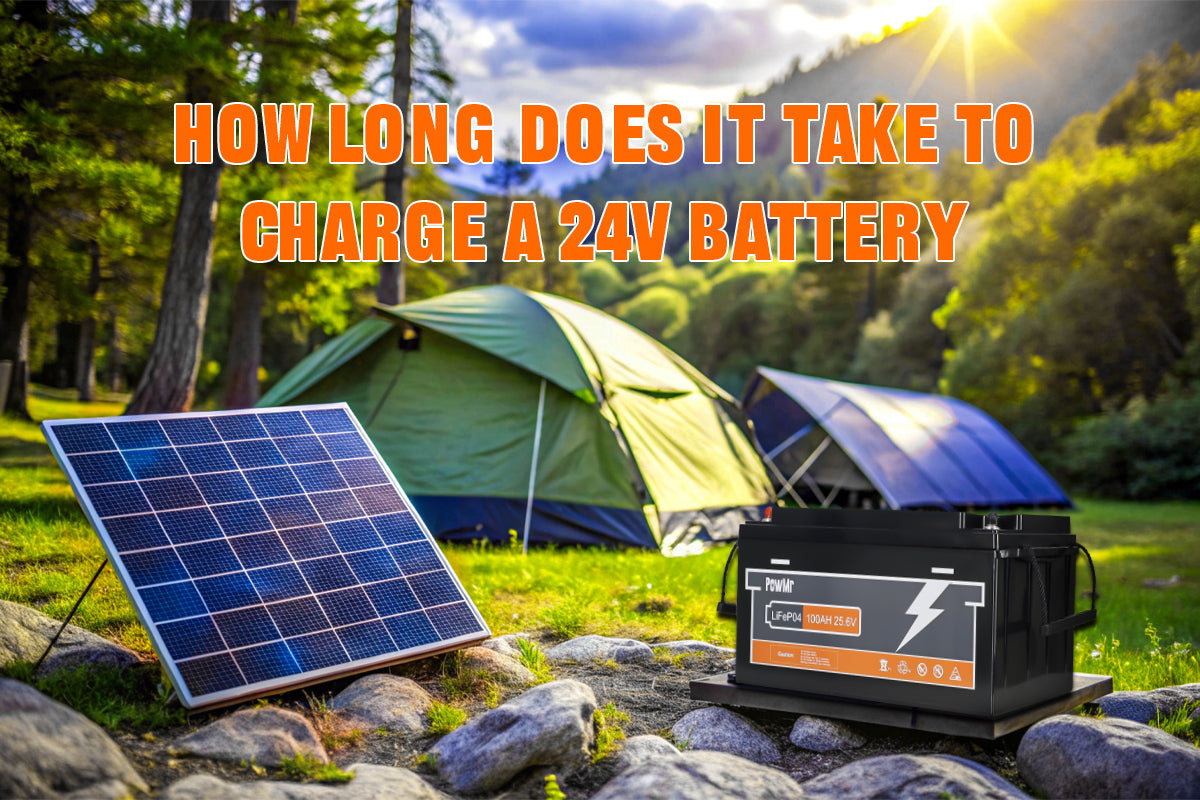อินเวอร์เตอร์ 2000W เป็นตัวเลือกยอดนิยมสำหรับ การผจญภัยนอกกริด ไม่ว่าคุณจะใช้พลังงานสำหรับ RV, เรือ, หรือแคมป์ปิ้ง มันให้พลังงานที่เชื่อถือได้สำหรับการใช้งานอุปกรณ์ที่จำเป็น เช่น ตู้เย็น, ไฟ, และอุปกรณ์อิเล็กทรอนิกส์ขนาดเล็ก ทำให้คุณสามารถเพลิดเพลินกับความสะดวกสบายของบ้านได้ทุกที่ที่คุณอยู่.
แต่การกำหนดจำนวนแบตเตอรี่ที่ถูกต้องเป็นสิ่งสำคัญ—ไม่เพียงแต่จะทำให้คุณ มีพลังงานเพียงพอต่อความต้องการ แต่ยังช่วยยืดอายุการใช้งานของแบตเตอรี่และเพิ่มประสิทธิภาพอีกด้วย.
ในคู่มือนี้ เราจะอธิบาย ปัจจัยสำคัญที่กำหนด จำนวนแบตเตอรี่ที่จำเป็นสำหรับอินเวอร์เตอร์ 2000W พร้อมกับ ตัวอย่างการคำนวณแบบทีละขั้นตอน เพื่อให้คุณสามารถเพลิดเพลินกับพลังงานโดยไม่ต้องกังวลในผจญภัยครั้งถัดไปของคุณ.
สี่ปัจจัยที่มีผลต่อจำนวนแบตเตอรี่สำหรับอินเวอร์เตอร์ 2000W
1. กำลังไฟฟ้าที่Ratedของอินเวอร์เตอร์และประสิทธิภาพ
กำลังไฟที่ระบุของอินเวอร์เตอร์แสดงถึงความสามารถในการรับภาระสูงสุด ประสิทธิภาพกำหนดว่าต้องใช้พลังงานจากแบตเตอรี่เท่าใดเพื่อให้ได้ผลลัพธ์นี้
2. เวลาทำงานของอินเวอร์เตอร์
ระยะเวลาการทำงานมีผลโดยตรงต่อการใช้พลังงานรวม ยิ่งอินเวอร์เตอร์ทำงานนานเท่าไหร่ ก็ยิ่งดึงพลังงานจากแบตเตอรี่มากขึ้นเท่านั้น ซึ่งจำเป็นต้องมีแบตเตอรี่เพิ่มเติมเพื่อให้แน่ใจว่ามีการจ่ายพลังงานเพียงพอสำหรับการใช้งานที่ยาวนานโดยไม่ทำให้พลังงานที่เก็บไว้หมดไป.
3. แรงดันไฟแบตเตอรี่
แรงดันไฟฟ้าของระบบแบตเตอรี่ มีผลต่อจำนวนแบตเตอรี่ที่ต้องการ ระบบแรงดันไฟฟ้าสูงกว่า (เช่น 24V) สามารถลดจำนวนแบตเตอรี่รวมเมื่อเปรียบเทียบกับระบบแรงดันไฟฟ้าต่ำกว่า (เช่น 12V) ในขณะที่ยังคงตอบสนองความต้องการพลังงานได้อย่างมีประสิทธิภาพ.
4. ความจุของแบตเตอรี่
ความจุของแบตเตอรี่ ซึ่งวัดเป็นแอมป์-ชั่วโมง (Ah) กำหนดว่ามีพลังงานเท่าใดที่แบตเตอรี่แต่ละก้อนสามารถเก็บได้ แบตเตอรี่ที่มีความจุมากกว่าจะให้พลังงานมากขึ้น ทำให้คุณสามารถใช้แบตเตอรี่ได้น้อยลงเพื่อตอบสนองความต้องการพลังงานของอินเวอร์เตอร์ 2000W ของคุณในระยะเวลาที่ต้องการ.
การคำนวณแบบทีละขั้นตอน: ต้องใช้แบตเตอรี่กี่ก้อนสำหรับอินเวอร์เตอร์ 2000W?
ขั้นตอนที่ 1 - คำนวณจำนวนวัตต์ที่ต้องการจากแบตเตอรี่
อินเวอร์เตอร์แปลงพลังงาน DC จากแบตเตอรี่เป็นพลังงาน AC สำหรับอุปกรณ์ในบ้าน แต่การแปลงนี้ ไม่ถึง 100% มีความหมายว่าการส่งออก 2000W อินเวอร์เตอร์จะดึงพลังงานจากแบตเตอรี่มากกว่า 2000W เล็กน้อย.
การคำนวณนี้ช่วยกำหนดการใช้พลังงานรวม ซึ่งจะช่วยในการกำหนดขนาดและจำนวนแบตเตอรี่ของเรา
- พลังงานที่ต้องการจากแบตเตอรี่ = กำลังไฟที่กำหนดของอินเวอร์เตอร์ ÷ ประสิทธิภาพของอินเวอร์เตอร์
สมมติว่าคุณกำลังใช้ PowMr อินเวอร์เตอร์ 2000W ที่มีประสิทธิภาพ 92%.
พลังงานที่ต้องการจากแบตเตอรี่ = 2000W ÷ 0.92 (ประสิทธิภาพของอินเวอร์เตอร์) ≈ 2174W.

ขั้นตอนที่ 2 - คำนวณว่าอินเวอร์เตอร์ 2000W ใช้กระแสไฟฟ้ากี่แอมป์
ขั้นตอนถัดไปคือการหาว่า อินเวอร์เตอร์ 2000W จะดึงกระแสไฟฟ้ากี่แอมป์ จากแบตเตอรี่ เนื่องจากจะมีผลต่อขนาดแบตเตอรี่และความต้องการการเดินสายไฟด้วย
เพื่อกำหนดจำนวนแบตเตอรี่ที่ต้องการ เราต้องคำนวณการดึงกระแสของอินเวอร์เตอร์ 2000W เป็นแอมป์ก่อน โดยใช้สูตรด้านล่างนี้:
- แอมป์ที่ต้องการ = พลังงาน (W) ÷ แรงดันไฟฟ้า (V)
เมื่อใช้ แบตเตอรี่ 12V กระแสที่ต้องการเพื่อรองรับอินเวอร์เตอร์ 2000W โดยคำนึงถึงประสิทธิภาพ จะอยู่ที่ประมาณ 181 แอมป์ (2174W ÷ 12V ≈ 181 แอมป์).
ในทางตรงกันข้าม ด้วย แบตเตอรี่ 24V อินเวอร์เตอร์จะดึงกระแสประมาณ 90.5 แอมป์ (2174W ÷ 24V ≈ 90.5 แอมป์).
ขั้นตอนที่ 3 - กำหนดขนาดของระบบแบตเตอรี่ที่คุณต้องการสำหรับอินเวอร์เตอร์ 2000W
เมื่อคุณทราบจำนวนแอมป์ที่ต้องการแล้ว คุณสามารถคำนวณ ความจุแบตเตอรี่ ที่จำเป็นในการจ่ายไฟให้กับอินเวอร์เตอร์ของคุณในช่วงเวลาที่กำหนด โดยใช้สูตรด้านล่าง:
- ขนาดระบบแบตเตอรี่ (Ah) = กระแสรวม × เวลาทำงานที่คาดหวัง (ชั่วโมง)
สมมติว่าคุณต้องการให้เครื่องแปลงไฟ 2000W ทำงานเป็นเวลา 2 ชั่วโมง โดยใช้ความต้องการกระแสไฟฟ้าที่คำนวณไว้ข้างต้น:
สำหรับ อินเวอร์เตอร์พลังงาน 12V 2000W: ขนาดระบบแบตเตอรี่ = 181 แอมป์ × 2 ชั่วโมง = 362Ah
สำหรับ อินเวอร์เตอร์พลังงาน 24V 2000w: ขนาดระบบแบตเตอรี่ = 90.5 แอมป์ × 2 ชั่วโมง ≈ 181Ah
บันทึก:
สิ่งสำคัญคือต้องพิจารณาว่า โหลดเหนี่ยวนำ เช่น ไมโครเวฟหรือตู้เย็นขนาดเล็ก อาจดึงพลังงานเพิ่มเติมเมื่อเริ่มทำงาน ซึ่งเรียกว่า "พลังงานกระชาก" พลังงานกระชากนี้อาจสูงกว่ากำลังวัตต์ที่ทำงานอยู่มาก ซึ่งอาจนำไปสู่การ เกินกำลังของอินเวอร์เตอร์ หากไม่คำนึงถึง ยกเว้นว่า อินเวอร์เตอร์ถูกออกแบบมาสำหรับโหลดหนัก.
การตรวจสอบกำลังวัตต์ของแต่ละอุปกรณ์และพิจารณาความต้องการพลังงานกระชากจะช่วยให้คุณหลีกเลี่ยงการโหลดเกินระบบ ทำให้มั่นใจได้ว่ามีการจ่ายพลังงานที่ราบรื่นและมีประสิทธิภาพสำหรับความต้องการนอกกริดของคุณ.
โดยทั่วไปแล้ว คุณควรคำนึงถึง ส่วนต่าง 30 - 50% ของความจุแบตเตอรี่รวมเพื่อรองรับการเพิ่มขึ้นนี้ ส่วนต่างนี้ช่วยให้มั่นใจได้ว่าอินเวอร์เตอร์ของคุณสามารถจัดการกับการเพิ่มขึ้นชั่วคราวเหล่านี้ได้โดยไม่ทำให้การป้องกันการโอเวอร์โหลดทำงาน ทำให้การทำงานราบรื่นสำหรับอุปกรณ์ที่เชื่อมต่อทั้งหมด.
ขั้นตอนที่ 4 - คำนวณจำนวนแบตเตอรี่ที่คุณต้องการสำหรับอินเวอร์เตอร์ 2000W
สุดท้าย มาหา จำนวนแบตเตอรี่ที่คุณต้องการ เพื่อให้ได้ความจุรวมนี้กันเถอะ.
- จำนวนแบตเตอรี่ = ขนาดระบบแบตเตอรี่ (Ah) ÷ ความจุแบตเตอรี่ที่ใช้งานได้ต่อหน่วย
สมมติว่าคุณใช้ PowMr แบตเตอรี่ลิเธียม 100Ah ที่มีความลึกในการปล่อยประจุ (DoD) 80% ความจุที่ใช้งานได้ต่อแบตเตอรี่คือ:
ความจุที่ใช้งานได้ = 100Ah × 80% = 80Ah
ตอนนี้ นำสิ่งนี้ไปใช้กับข้อกำหนดของระบบแบตเตอรี่ที่คำนวณไว้ข้างต้น:
สำหรับการติดตั้ง แบตเตอรี่ 12V 100Ah:จำนวนแบตเตอรี่ = 362Ah ÷ 80Ah ≈ 4.5
สำหรับการติดตั้ง แบตเตอรี่ 24V 100Ah:จำนวนแบตเตอรี่ = 181Ah ÷ 80Ah ≈ 2.25
เนื่องจากแบตเตอรี่บางส่วนไม่สามารถใช้งานได้ ให้ปัดขึ้นเพื่อให้แน่ใจว่ามีพลังงานเพียงพอ อินเวอร์เตอร์ 24V 2000W ที่ทำงานเป็นเวลา 2 ชั่วโมงต้องการแบตเตอรี่ไม่น้อยกว่า 5 ก้อน ในขณะที่อินเวอร์เตอร์ 12V 2000W ต้องการแบตเตอรี่ไม่น้อยกว่า 3 ก้อน.
บทสรุป
ขนาดของแบตเตอรี่ที่คุณต้องการขึ้นอยู่กับระยะเวลาที่ต้องการใช้งานและประสิทธิภาพของอินเวอร์เตอร์ของคุณ โดยทั่วไปแล้ว:
สำหรับการใช้งานระยะสั้น (เช่น น้อยกว่าหนึ่งชั่วโมง) แบตเตอรี่ความจุสูงขนาด 100Ah เพียงก้อนเดียวอาจให้พลังงานเพียงพอ.
สำหรับการใช้งานที่ยาวนาน คุณจะต้องมีแบตเตอรี่หลายก้อนหรือแบตเตอรี่แบงค์ขนาดใหญ่เพื่อรองรับการใช้งานอย่างต่อเนื่อง ตัวอย่างเช่น การใช้งานอินเวอร์เตอร์ 2000W เป็นเวลา 2 ชั่วโมงด้วยระบบแบตเตอรี่ 12V จะต้องการความจุประมาณ 362Ah ซึ่งแปลเป็นแบตเตอรี่ขนาด 100Ah จำนวนประมาณ 4 ก้อน โดยมี DoD 80%.
คำตอบขึ้นอยู่กับปัจจัยต่างๆ เช่น ประเภทแบตเตอรี่ แรงดันไฟฟ้า และความต้องการในการใช้งาน แบตเตอรี่ลิเธียม ตัวอย่างเช่น สามารถให้วงจรชีวิตที่ยาวนานกว่าและพลังงานที่สม่ำเสมอ เมื่อเปรียบเทียบกับแบตเตอรี่ตะกั่ว-กรด.



